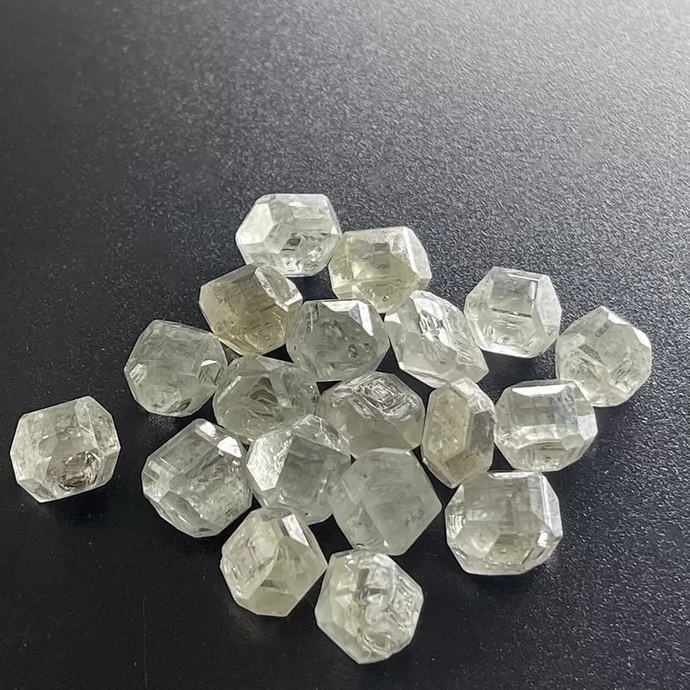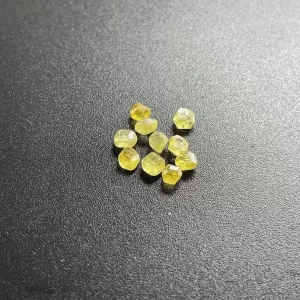5 To 6 Carat Big Sizes Synthetic Colored Diamonds Brown Greenish Yellow Diamond
5 – 6 Carat Big Sizes Synthetic Colored Diamonds With Greenish And Brown Color
Synthetic Colored Diamonds Description
What is laboratory diamond?
Laboratory diamond, also known as laboratory made diamond, synthetic diamond. Like natural diamonds, laboratory diamonds are also real diamonds. Because laboratory diamonds have the same chemical, physical and optical properties as mining diamonds. Carbon is the main chemical component of natural diamonds and laboratory diamonds. When people observe with naked eyes, it is impossible to distinguish between the diamonds produced in the laboratory and the diamonds mined. The main difference between the two is the environment in which they grow.
Laboratory grown diamonds are sometimes called CVD diamonds or HPHT diamonds. The reason is that CVD and HPHT are two ways to make diamonds.
Tidbits about lab-grown diamonds
Why Buy Synthetic Colored Diamonds in Big Sizes?
If you’ve ever wanted a diamond ring that’s larger than your finger, you may be interested in lab-grown color diamonds. These are much less expensive than natural diamonds, and they can grow as large as the lab chooses. Plus, the manufacturing process makes them highly predictable, and scientists can predict the size, color, and clarity of each diamond. Earlier synthetic diamonds were an unappealing brownish color or colorless, but scientists and jewelers are now able to grow them in large, beautiful sizes. In fact, you can even have them grown in any color or any size that you want, and they are very durable.
Lab grown diamonds are available in a wide range of colors
While diamonds of all colors are precious, lab grown diamonds come in a wide range of colors for large sizes. Diamonds of HPHT and CVD labs have a soft yellowish tint. Lab grown diamonds of F and G color grades are solid browns and greys, respectively. This color variation is normal and will be undetectable by the naked eye.
Whether a lab-grown diamond is natural or synthetic, it will always come with a grading report from a respected gemological laboratory. For instance, the GIA and the IGI both provide particular grades for diamonds. Ask to see the certificate. The gemological institute uses the same scale to grade the diamonds. A ‘D’ graded diamond will be completely colorless, while a Z-graded diamond will have noticeable yellow or brown color.
The cost of lab grown diamonds is often significantly lower than that of natural diamonds. This is especially true for big-size diamonds, which are generally very expensive. In addition, a lab-grown diamond is available in a variety of colors, ranging from white to pink. They are also much more affordable, with prices starting at around $800 per carat. Lab grown diamonds can be a great alternative to natural diamonds in the center of a large engagement ring.
While some people are skeptical about buying a lab-grown diamond, it is important to understand that these stones are very similar to natural diamonds. Lab-grown diamonds share the same carbon structure as natural diamonds, although the process of creation is sped up in the laboratory. Because these diamonds are created in a controlled environment, they have the same durability and spark as natural diamonds.
They can be grown as large as the lab decides
Natural diamonds are colorless and can be grown as large as the lab decide – but lab-grown colored diamonds can be any color the customer would like. Natural colored diamonds come in colors like pink and blue, but these diamonds are incredibly expensive. Synthetic colored diamonds can be grown in a wide range of colors, and can be produced in large quantities. They are also affordable compared to natural colored diamonds, as lab-grown diamonds can be produced in large volumes.
Some couples prefer lab-grown diamonds over mined ones because the lab-grown diamonds don’t have to be extracted from the Earth. They are also considered ethically sourced, which makes them a better option for the environment. However, they should be considered a luxury purchase. Because they do not grow as large as natural diamonds, they have a lower cost of ownership.
Although a lab-grown diamond has the same physical properties as a natural diamond, a professional jeweler cannot tell the difference between the two. To tell a synthetic diamond from a natural diamond, a jeweler must look for inclusions. Often these inclusions are laser-etched with a report number and the synthetic status. However, a professional jeweler may also be able to identify a synthetic colored diamond by its report number. Because lab-grown diamonds are manufactured under strict guidelines, manufacturers and jewelers have to report information about them. If you’re thinking of buying synthetic diamonds, be sure to get a certificate of origin.
They are cheaper than natural diamonds
Buying lab-grown diamonds is much cheaper than purchasing natural ones, saving you anywhere from 20 to 40%. These man-made diamonds are not controlled by the same supply chain as natural diamonds, so their prices can go much lower. In addition to saving money, lab-grown diamonds are not harmful to the environment. They share many of the same physical properties as natural diamonds. In addition, they do not cost as much as natural diamonds because their supply is unlimited.
Inclusions in natural diamonds affect its value, and synthetic diamonds may contain metallic flux that changes the stone’s color and brilliance. Some synthetic diamonds are even charged, creating a phosphorescent effect. This effect is not noticeable until the stone has been worn and is in direct sunlight. If you are buying a diamond for your own self, you should choose the best one based on the cut, color, and carat weight.
Besides being cheaper, lab-grown diamonds also have the same optical properties as natural diamonds. But they do not have the same value as natural diamonds, which makes them less desirable as an investment. While natural diamonds increase in value with inflation, lab-grown diamonds are cheaper. They also come with the same durability and beauty. In addition to being cheaper, lab-grown diamonds are also more durable and resale-worthy.
They are more durable than natural diamonds
Although lab-created diamonds are the closest thing to real ones, they do not compare to a real one in many ways. For one thing, synthetic colored diamonds do not show the brilliance and sparkle of a natural diamond. While both have similar hardness and refractive index, moissanite has a higher one than cubic zirconia. These diamonds give off a colorful reflection that many people find unappealing. While these synthetic alternatives are not as expensive as natural diamonds, they can still be a good substitute for big size diamonds.
Another benefit of synthetic diamonds is their eco-friendliness. Due to the process used to grow them, they do not impact the land in any way. They are not carved from huge mountain ranges or transported across huge waterways. Instead, they grow in a machine. This means that the synthetic diamonds do not impact the environment as much as natural diamonds do. In addition, they have lower emissions, which are an after-effect of using oil to create diamonds.
Because synthetic colored diamonds are made of carbon, they are more durable than natural diamonds in big sizes. Natural diamonds are more durable than lab-created diamonds, but the latter tend to be more durable for big sizes. These diamonds are created in laboratories, and they mimic the appearance of natural diamonds. Nevertheless, lab-created diamonds are more expensive than natural ones.
They have the same optical properties as natural diamonds
Although lab-grown diamonds have the same optical properties as natural ones, they do not have the brilliance and sparkle of the real thing. While synthetic colored diamonds do have a lower refractive index than natural diamonds, they have the same optical properties. While this makes them cheaper, they are not nearly as durable. However, they do look like diamonds. So, how do you tell the difference?
Although synthetic colored and big size colored diamonds share the same optical properties as natural diamonds, they are not the same as the real thing. A synthetic diamond’s color can be altered by heating it at high temperatures. This will alter the color of the diamond and make it appear blue. However, the optical properties are almost identical to the real thing. Therefore, a synthetic diamond will be difficult to detect if it is cut or polished.
There are two main types of diamonds: lab-grown and natural. The chemical properties of natural diamonds are the same, so the appearance is identical. However, synthetic diamonds are far less expensive. Unless you’re willing to pay more for a diamond, the cheaper option is not the best option. Naturally colored diamonds have the highest value, so investing in them is an excellent way to increase your wealth.
They lack market share
While traditional diamonds still dominate the jewelry market, big-size synthetics are gaining in popularity. Traditional diamond purveyors like De Beers, which coined the phrase “A Diamond is Forever,” are starting to take notice. But synthetic diamonds have a long way to go before they can rival natural diamonds. Let’s take a look at some of the challenges facing the industry.
According to Robert H. Frank, professor of management at Cornell University’s Johnson Graduate School of Management, “While big-size synthetic colored diamonds may offer perfect replicas, they’ll never overcome people’s strong preferences for mined diamonds.” That’s why the synthetic colored diamonds industry has so far failed to capture a large share of the market. Ultimately, there are two possible scenarios.
The price differential between lab-grown and natural diamonds has become significant. At one time, lab-grown diamonds were priced at roughly half the price of their natural counterparts, stealing sales from natural diamonds. Now, though, the price difference has become so huge that lab-grown diamonds are starting to catch up. A one-carat lab diamond that cost $1,000 yesterday could be worth half of that price in just a year or two.
The Covid-19 pandemic affected the entire value chain, affecting the supply and demand sides. The economic downturn, lockdowns in major world cities, and restrictions on cross-border goods movement all contributed to a decline of 15% in diamond retail sales. However, despite these challenges, consumer interest in diamonds has remained strong. As a result, the industry must invest in omnichannel capabilities and encourage sustainable practices by manufacturers and retailers.
5 To 6 Carat Big Sizes Synthetic Colored Diamonds Brown Greenish Yellow Diamond

















